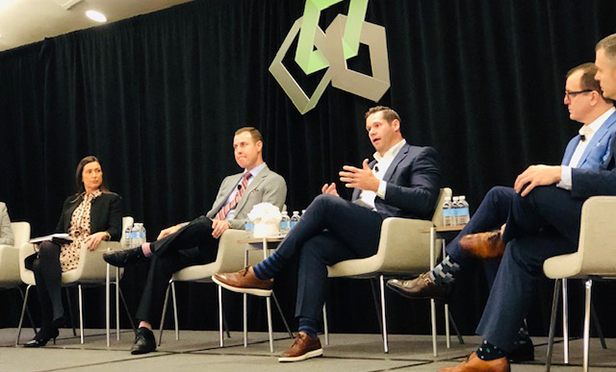 "Collaboration or Competition: Who Owns the Healthcare Dollar" panel at the NIC Spring Conference.
"Collaboration or Competition: Who Owns the Healthcare Dollar" panel at the NIC Spring Conference.
SAN DIEGO—More than 10,000 baby boomers turn 65 every day, but until recently there hasn't been significant focus on the implications of this demographic shift to the importance of connections between senior housing and healthcare. That is according to panelists at the recent NIC Spring Conference here in San Diego.
To be competitive in today's value-based healthcare system, panelists at the conference said that care must be coordinated, cost-effective for the public and private sectors, affordable for patients, and meet metrics for quality.
One session that explored the transition to value-based care from a fee-for-service payments system was titled "Collaboration or Competition: Who Owns the Healthcare Dollar," where speakers agreed that risk-sharing is a "team sport" that takes genuine cooperation.
As hospitals and health systems enter risk-sharing agreements with payors, senior housing, care facilities and more, partnership is the key component, explained panelist Skelly Wingard, NCAL regional director of care coordination and placement at Kaiser Permanente. Often times, Wingard continued, operators are changing how they portray value. "Overall, we are having daily, weekly and monthly accountability checks and it is worth the investment because the outcome is that we all succeed."
Panelist Scott Ford, a post-acute healthcare leaders at Ascension Living, said that "it is absolutely a team sport" and noted that the risk is in situational decisions. "I do believe the health system is better positioned to pull all of the different groups together to coordinate that care. In looking down the road, you will see health systems who will hold out for fee for service until that last drop but we firmly believe that in a couple of years, the landscape will not look like what it looks like today. We are looking at positioning ourselves to be at fee for value environment in 2025."
According to Jim Lydiard, general manager of the CareMore Touch program, we get caught up in the upside of risk, but you can't forget to talk about the downside of risk. "You have to be willing to get your hands dirty and take your losses," he said. "Our experience has been that the health system risk deals we have done have done a great job at driving membership but not done a great job at cost. Skilled nursing environments need to start talking about quality-based bonuses and the outcomes will speak for themselves."
Stay tuned for more from the NIC Spring Conference and check out the related articles below that you might have missed.
How Senior Housing Fits in the Healthcare Expenditure Equation
Panelists: Telehealth Will Produce Meaningful Savings for Senior Care
NIC 2020 Talks Future of Healthcare Disruption, Scale Will Matter
The Uncertain Demand for Senior Housing
New Investors Flock To Senior Living
© Touchpoint Markets, All Rights Reserved. Request academic re-use from www.copyright.com. All other uses, submit a request to [email protected]. For more inforrmation visit Asset & Logo Licensing.







